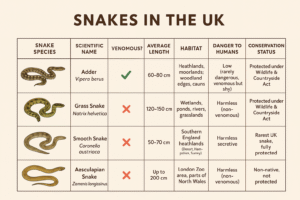When people think of snakes, their minds usually wander to exotic rainforests, deserts, or warm tropical countries where reptiles slither freely under the sun. But what about the United Kingdom? Do we actually have snakes here in Britain, or is that just a myth?
If you’ve ever asked yourself, “Are there snakes in the UK?” — the short answer is yes. But the longer answer is far more fascinating, because the UK is home to a few native snake species, each with its own role in nature, unique appearance, and sometimes a bit of an undeserved reputation.
In this guide, I’ll walk you through everything you need to know about snakes in the UK — from the species you might encounter, to where they live, what to do if you spot one, and even their cultural significance in British history. By the end of this article, you’ll not only know if there are snakes in the UK, but you’ll have a full understanding of their lifestyle, behavior, and importance.
Do Snakes Really Exist in the UK?
Yes, absolutely. Despite the UK’s relatively cool climate, we do have native snake species. They may not be as diverse or as colorful as the snakes found in tropical parts of the world, but they are here, quietly playing their role in our ecosystem.
The UK is home to three native snake species and one non-native species that has established itself in the wild:
- Adder (Vipera berus) – The only venomous snake in the UK.
- Grass Snake (Natrix helvetica) – A non-venomous snake, the UK’s largest.
- Smooth Snake (Coronella austriaca) – Rare and found only in specific heathlands.
- Aesculapian Snake (Zamenis longissimus) – A non-native snake that has adapted to some parts of Britain.
These are the snakes you might encounter if you spend time exploring the countryside, woodlands, or heathlands. Let’s look at each of them more closely.
1. The Adder (Vipera berus) – The UK’s Only Venomous Snake
When people ask “are there dangerous snakes in the UK?”, the adder usually comes to mind.
- Appearance: Adders are relatively small, usually between 60–80 cm long. They have a distinctive zig-zag pattern running along their back, often black or dark brown on a grey or brown body. Their eyes are strikingly red or copper-colored.
- Habitat: They prefer heathlands, moorlands, woodland edges, and coastal dunes.
- Venom: Adders are venomous, but their bite is rarely life-threatening. Most bites happen when people accidentally step on them or disturb them. For healthy adults, bites usually cause swelling, pain, and discomfort. However, children, pets, and vulnerable adults should seek immediate medical care if bitten.
- Behavior: Adders are shy creatures. They would much rather slither away than confront a human.
👉 Fun Fact: The adder is the most widespread snake species in Europe, ranging from the UK to as far east as Asia.
2. Grass Snake (Natrix helvetica) – Britain’s Gentle Giant
The grass snake is the UK’s largest native snake, often growing up to 150 cm (1.5 meters).
- Appearance: Olive-green or brown with a yellow and black collar just behind the head. They sometimes get mistaken for adders, but they lack the zig-zag pattern.
- Habitat: They love wetlands, ponds, and rivers because they are strong swimmers and primarily feed on amphibians like frogs and newts.
- Venom: Grass snakes are completely harmless. They don’t produce venom and rely on constriction (though very lightly) to subdue prey.
- Behavior: When threatened, they might “play dead” by rolling onto their back and even releasing a foul smell to deter predators.
👉 Fun Fact: Grass snakes are more common in southern England and are rarely found in Scotland.
3. Smooth Snake (Coronella austriaca) – The Rare and Secretive One
The smooth snake is the rarest and hardest to spot in the UK.
- Appearance: Smaller and slimmer than grass snakes, with smooth scales (hence the name). They’re usually grey or brown with dark markings.
- Habitat: Found only in a few heathland sites in southern England, such as Dorset, Hampshire, and Surrey.
- Venom: Like grass snakes, smooth snakes are non-venomous and harmless to humans.
- Behavior: They are secretive and spend much of their lives hidden under vegetation or basking discreetly in the sun.
👉 Conservation Note: The smooth snake is a protected species under UK law, meaning harming or disturbing them is illegal.
4. The Non-Native Aesculapian Snake
Surprisingly, there’s also a non-native snake living in parts of the UK — the Aesculapian snake.
- Appearance: Can grow up to 2 meters long, making it one of Europe’s largest snakes.
- Habitat: Found around the London Zoo area and in parts of North Wales, where populations have survived after escaping captivity.
- Venom: Non-venomous and not dangerous to humans.
- Behavior: They feed mostly on rodents and birds, and have adapted quite well to the British climate.
👉 Fun Fact: This snake is named after Asclepius, the Greek god of healing, whose staff with a snake wrapped around it remains a symbol of medicine today.
Where Are Snakes Found in the UK?
Snakes in the UK are not everywhere — you’re unlikely to see one in your back garden in central London. But they do exist in specific habitats:
- Heathlands and Moorlands – Adders and smooth snakes thrive here.
- Woodlands and Forest Edges – Adders can sometimes be spotted basking.
- Wetlands, Ponds, and Rivers – Grass snakes prefer watery areas.
- Urban “pockets” – Aesculapian snakes near certain cities.
If you’re in the countryside during warm months (April to September), your chances of spotting a snake increase.
When Are Snakes Active in the UK?
Because the UK has a cool climate, snakes are only active during the warmer months.
- Hibernation: From October to March, most snakes hibernate underground.
- Spring: They emerge to bask in the sun and regain energy.
- Summer: Mating season and peak activity.
- Autumn: They feed heavily to prepare for winter hibernation.
So, if you’re hiking in July or August, you’re most likely to encounter one.
Are UK Snakes Dangerous?
This is the most common concern people have. The truth is:
- Only the adder is venomous.
- Adders are shy and bites are very rare.
- Grass snakes, smooth snakes, and Aesculapian snakes are harmless.
👉 According to official NHS statistics, there have been no recorded deaths from adder bites in the UK since 1975.
So, while it’s wise to respect snakes and keep your distance, they pose very little danger to humans.
What To Do If You See a Snake in the UK
If you’re lucky enough to spot a snake in the UK, here’s what you should do:
- Stay calm – Don’t panic or try to kill it.
- Keep your distance – Snakes usually slither away if undisturbed.
- Don’t pick it up – Even non-venomous snakes can bite defensively.
- Respect their space – Remember, snakes are protected species.
- If bitten by an adder – Seek medical help immediately, though most bites are not life-threatening.
Snakes and British Culture
Snakes have always held a special place in myths, legends, and folklore.
- In Celtic mythology, snakes symbolized rebirth and healing.
- St. Patrick is often associated with banishing snakes from Ireland (though that’s more legend than fact).
- The adder appears in old English poetry and rural tales, often misunderstood but respected.
Why Snakes Are Important in the UK
Snakes play a vital role in the ecosystem:
- Control pests – Grass snakes and adders keep rodent populations in check.
- Food chain balance – They are prey for birds like buzzards and herons.
- Biodiversity – Snakes are indicators of healthy habitats.
Protecting them means protecting the balance of nature itself.

Comparison Table: Snakes in the UK
| Snake Species | Scientific Name | Venomous? | Average Length | Habitat | Danger to Humans | Conservation Status |
|---|---|---|---|---|---|---|
| Adder | Vipera berus | ✅ Yes | 60–80 cm | Heathlands, moorlands, woodland edges, coastal dunes | Low (rarely dangerous, venomous but shy) | Protected under Wildlife & Countryside Act |
| Grass Snake | Natrix helvetica | ❌ No | 120–150 cm | Wetlands, ponds, rivers, grasslands | Harmless (non-venomous) | Protected under Wildlife & Countryside Act |
| Smooth Snake | Coronella austriaca | ❌ No | 50–70 cm | Southern England heathlands (Dorset, Hampshire, Surrey) | Harmless, secretive | Rarest UK snake, fully protected |
| Aesculapian Snake (non-native) | Zamenis longissimus | ❌ No | Up to 200 cm | London Zoo area, parts of North Wales | Harmless (non-venomous) | Non-native, not protected |
FAQs About Snakes in the UK
Q1. Are there snakes in London?
In central London, no — but grass snakes and even Aesculapian snakes exist in some areas around the outskirts.
Q2. Are there snakes in Scotland?
Yes, adders are found in parts of Scotland, especially in the Highlands. Grass snakes are less common there.
Q3. What’s the most common snake in the UK?
The grass snake is the most widespread and frequently encountered.
Q4. Can you keep snakes as pets in the UK?
Yes, many non-native species are kept as pets, such as corn snakes, royal pythons, and king snakes.
Q5. Are UK snakes protected by law?
Yes, all native snake species are legally protected under the Wildlife and Countryside Act 1981.
Final Thoughts – Are There Snakes in the UK?
So, back to the main question: Are there snakes in the UK? The answer is a definite yes.
From the shy adder, to the water-loving grass snake, the rare smooth snake, and even the surprising Aesculapian snake, Britain has its fair share of serpents — though they often go unnoticed by most people.
They may not be as flashy or as dangerous as snakes in tropical lands, but they are part of our natural heritage. And far from being creatures to fear, they are animals to respect and protect.
Next time you’re walking in the countryside and spot something slithering away into the grass, remember: it’s probably more scared of you than you are of it.

Written by
Imtiaz Ivan
Chief Editor at Animal Ranger